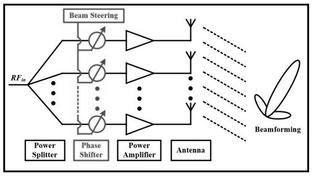Inverted-F Antenna: Advantages and Disadvantages
Advertisement
This page explores the pros and cons of Inverted-F Antennas. It highlights the advantages and disadvantages of this antenna type, providing a balanced perspective.
What is an Inverted-F Antenna?
Introduction:
- The Inverted-F Antenna is an evolution of the λ/4 monopole antenna.
- Its sideways “F” shape gives it the name “inverted-F antenna.”
- It exists in various forms, including printed inverted-F antennas, meandered printed inverted-F antennas, and planar inverted-F antennas.
- The planar version is particularly popular in wireless communication due to the advantages of microstrip technology. This version is similar to a patch antenna, but with its characteristic F-shape.
 Inverted-F Antenna
Inverted-F Antenna
- Figure 1 (above) shows an inverted-F antenna that can be easily etched onto one side of a PCB (Printed Circuit Board) alongside other circuits used for mounting RF components. The ground plane is removed from underneath the antenna.
- PIFA (Planar Inverted-F Antenna) functions as a short-circuited microstrip antenna due to its structure.
Benefits or Advantages of Inverted-F Antennas
Here are the main advantages of using an Inverted-F Antenna:
- Economical: It’s cost-effective because it utilizes the same PCB as other RF components for fabrication.
- Compact Size: The antenna is compact and smaller in size compared to a monopole antenna.
- No External Matching Components: It doesn’t require any external components for impedance matching due to its intermediate feed point.
- Adjustable Bandwidth: The bandwidth of the PIFA can be adjusted by varying the size of the ground plane.
Drawbacks or Disadvantages of Inverted-F Antennas
Here are the main disadvantages of using an Inverted-F Antenna:
- Narrow Bandwidth: It offers a narrow bandwidth. Lengthening the inverted-F antenna can provide a wider bandwidth, but at the cost of increased radiation resistance. Other techniques are also employed to achieve wider bandwidth.
- Microstrip Limitations: As it uses a microstrip line structure for its construction. It can also incur drawbacks similar to PIFAs.
Summary
The Inverted-F Antenna (IFA) and its variant such as the Planar Inverted-F Antenna (PIFA), are widely utilized in modern wireless communication devices due to their compact size, efficient performance and ease of integration into small electronic devices. They offer advantages such as good radiation efficiency, relatively wide bandwidth, and suitability for multi-band operations. However, these antennas also present certain challenges, including narrow bandwidth and lower gain compared to other antenna types like patch antennas.
 RF
RF


